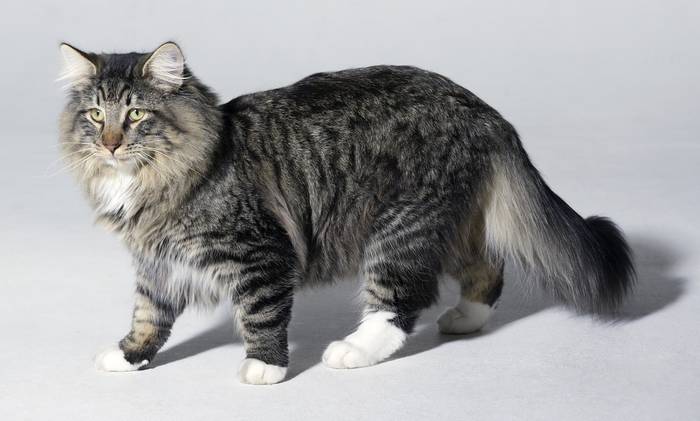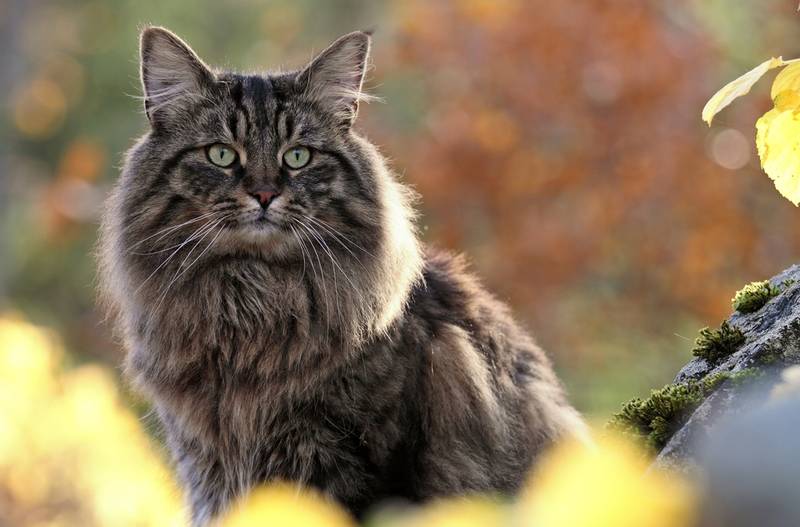The Norwegian Forest Cat inspires with its wild appearance and unadulterated character. But not only the appearance of the Norwegians is original. Read everything you need to know about this natural breed in the following article.
Appearance: Stately Cats with Half-length Fur

Like the Maine Coon and the Ragdoll, the Norwegian Forest Cat belongs to the group of semi-longhair cats. Their two-layer fur consists of water-repellent, oily outer hair with longer guard hairs and a thick undercoat.
Similar to the Siberian cat, the Norwegian forest cat also changes its fur with the change of seasons. Their winter fur with a thick undercoat is particularly plush and warms the cat in the cold winter months of their home. Thick tufts of hair can even be found between the toes as protection from snow and moisture. The ruff is well developed and particularly plush.
In summer the Norwegian Forest Cat then loses a large part of its undercoat. But she keeps her bushy tail and her “snowshoes”.
With the Norwegian Forest Cat, all known colors of the house cat are allowed, preferably in combination with white. Whether brindle, mackerel, spotted or ticked, black, blue, amber, tortoiseshell, or the respective combinations – a Norwegian forest cat is always a feast for the eyes. Only the color chocolate and its dilution Lilac, Cinnamon, and Fawn as well as the point pattern are excluded from the standard.
The Norwegians are one of the big breeds of cats. As such, they don’t mature until they are three to four years old. They reach a shoulder height of 40 to 45 centimeters. Then males weigh up to eight kilograms, queens around five kilograms.
According to the breed standard, their face is triangular with ears set high. These can be provided with tufts of fur on the inside and the tips of the ears. The profile of the Norwegian Forest Cat is straight and does not show any stop.
Temperament: Norwegian Forest Cats are Peace-loving and Gentle

It is not for nothing that the Norwegians are considered “gentle giants”. Friends of the breed are particularly enthusiastic about their friendliness. Despite their size, the beautiful cats are extremely peaceful and gentle. They are also very sociable animals who unconditionally join their humans and want to be there everywhere.
In addition to their preference for extended cuddles, playing and hunting should not be neglected either. Otherwise, the intelligent Norwegians quickly get bored. They are extremely curious and require both physical and mental exercise.
How Great is the Norwegian Woman’s Urge to Move?

As a robust, original cat, the Norwegian Forest Cat does not have particularly high demands when it comes to keeping it in a species-appropriate manner. However, due to its size and urge to move, it is not necessarily suitable for keeping in a small apartment.
Norwegian forest cats are exceptionally skilled at jumping and climbing. She loves to play and hunt and wants to be encouraged accordingly. A secured garden or a secured balcony with trees or floor-to-ceiling scratching posts is best suited for this. This breed of cats is also happy to be outdoors all year round. After all, it protects its thick fur even from cold, wet winter weather.
A Good Companion
Their play instinct and their robustness also make the Norwegian Forest Cat a good playmate for children. She is considered tolerant and friendly and is rarely jumpy. The sociable animals can often be kept with other pets as well as with dogs.
However, socializing with another cat has clear advantages. After all, your Norwegian Forest Cat can only play, romp and cuddle with another cat the cat’s way.
Grooming: How Complex is Grooming for the Norwegian Forest Cat?

The coat of the Norwegians is rather robust and the cats mostly care for it alone. To avoid tangling the soft undercoat, you should still use a comb and brush once a week.
If you get your cat used to regular grooming at an early age, this is usually not a problem. During the coat change, malt paste and cat grass support the natural shedding of swallowed hair. This will also prevent hairballs from forming.
An annual check-up at the vet is also important. This is how you can identify possible diseases at an early stage. The veterinarian can also take this opportunity to examine your house tiger’s teeth.
Health: Norwegian Forest Cats are Naturally Robust
The Norwegian Forest Cat evolved through natural selection. This makes them one of the more robust cat breeds. Unfortunately, certain hereditary diseases do not stop at the Norwegians either:
Hypertrophic cardiomyopathy (HCM)
This heart disease manifests itself as a thickening of the heart muscle. A cardiac ultrasound of potential breeding animals is the best way to detect the inheritable disease early on. Affected Norwegians are then excluded from breeding. Unfortunately, HCM is not curable. However, a diagnosis offers treatment options so that affected cats can still enjoy a long life.
Glycogen Storage Disease IV (GSD4)
GSD4 is inherited recessively and is often only recognized late. If a kitten inherits the gene for the disease from only one parent, it is considered to be the carrier and may pass the disease on to its descendants. These cats should therefore not be used for breeding.
If the cat receives the gene from both parents, it becomes seriously ill: a malfunction in the glucose metabolism leads to excessive storage of glycogen (the storage form of glucose) in the liver, muscles, and nerve cells. Affected cats show neuromuscular disorders from around the age of five months and have a maximum life expectancy of only ten to 14 months.
Pyruvate Kinase Deficiency (PK)
Pyruvate kinase is an enzyme that is essential for the metabolism of red blood cells (erythrocytes). Affected animals lack this enzyme and so the lifespan of the erythrocytes is shortened. Anemia develops. This disease is also incurable and affected animals are to be excluded from breeding.
Apart from these hereditary diseases, Norwegian forest cats are usually very healthy animals. The average life expectancy is 15 to 18 years.
Purchase: How Do I Find a Norwegian Forest Cat?
Hereditary diseases such as HCM and GSD 4 repeatedly show how important regular examination, well-thought-out mating and the exclusion of carriers of the corresponding genes are. Professional, responsible breeding is, therefore, an expensive hobby.
The costs of a breeder do not only include stud costs and rearing costs for the young. He must feed parents and young animals healthily, regularly introduce them to the vet, vaccinate them and have them dewormed. In addition, there are the costs for examinations for hereditary diseases.
A reputable breeder also lovingly raises his kittens for at least twelve weeks. He socializes them and lets the mother and siblings’ kittens teach them everything they need to live. Membership in the breed club and the issuing of papers also cause additional costs.
This also explains the not exactly cheap price for a Norwegian Forest Cat. You have to budget for 700 to 1,000 dollars for the purchase of a Norwegian. The breeder just covers his costs and absolutely does not deserve a “golden nose”.
Of course, not every cat lover can afford such an amount. As an alternative, you can visit the local animal shelter. Pedigree animals often end up in the animal welfare department and maybe you will find the Norwegian forest cat of your dreams there?
But don’t forget one thing: Norwegians are social animals and should never be kept alone!
Origin: The Norwegian Forest Cat is a Natural Breed

The Norwegian Forest Cat is one of the few “original” cat breeds. It developed through the natural selection of its environment – for a long time without any action or targeted selection by humans. That is why the Norwegian Forest Cat is perfectly adapted to the harsh living conditions of its country of origin.
The story of the Norwegian forest cat, called “Norsk Skogatt” in its homeland, began like that of the European Shorthair: It hunted mice on Norwegian farms.
How exactly it came to the appearance of feral domestic cats with long fur is unknown. One hypothesis is that seafarers carried Persian cats on their ships and that these mated with the local cats without being noticed.
Independent mutations in the gene pool of Scandinavian cats are also a plausible explanation. The long-hair gene remained hidden and so long-haired animals kept appearing in litters of short-haired cat parents. These cats were the basis of the later Norwegian breed, which began in the 1930s. In 1938 a Norwegian Forest Cat was first exhibited in Oslo.
The outbreak of the Second World War brought the systematic breeding of the Norwegian Forest Cat to a standstill. This was not taken up again until the 1970s.
The Norwegian Forest Cat has been recognized by Norwegian breed clubs since 1972 and received its own breed standard as a result. In 1975 the first animals were registered with the Fédération Internationale Féline, or Fifé for short.



























